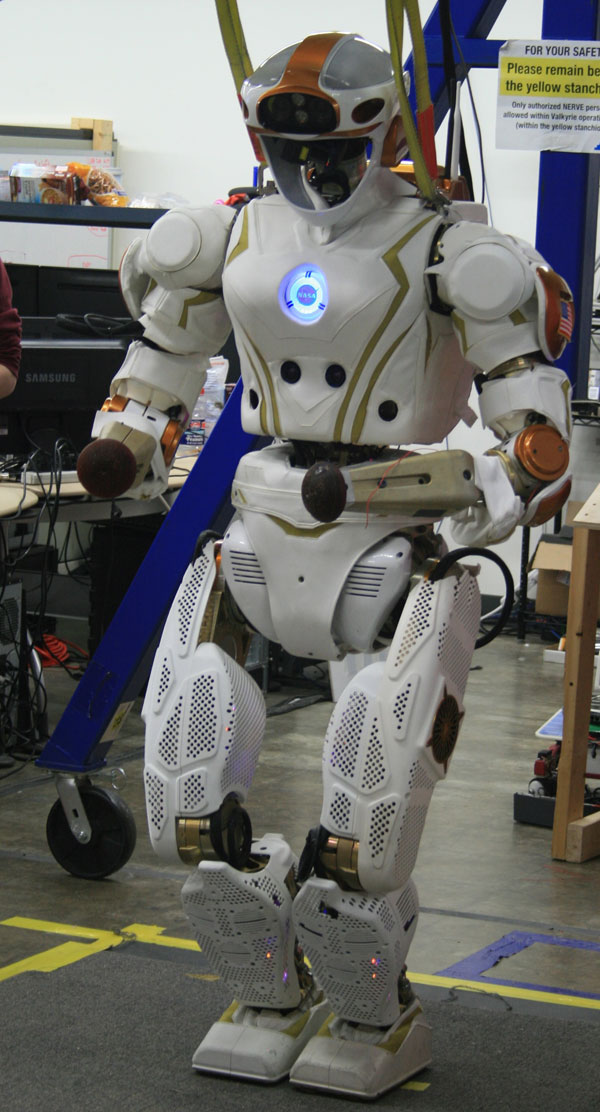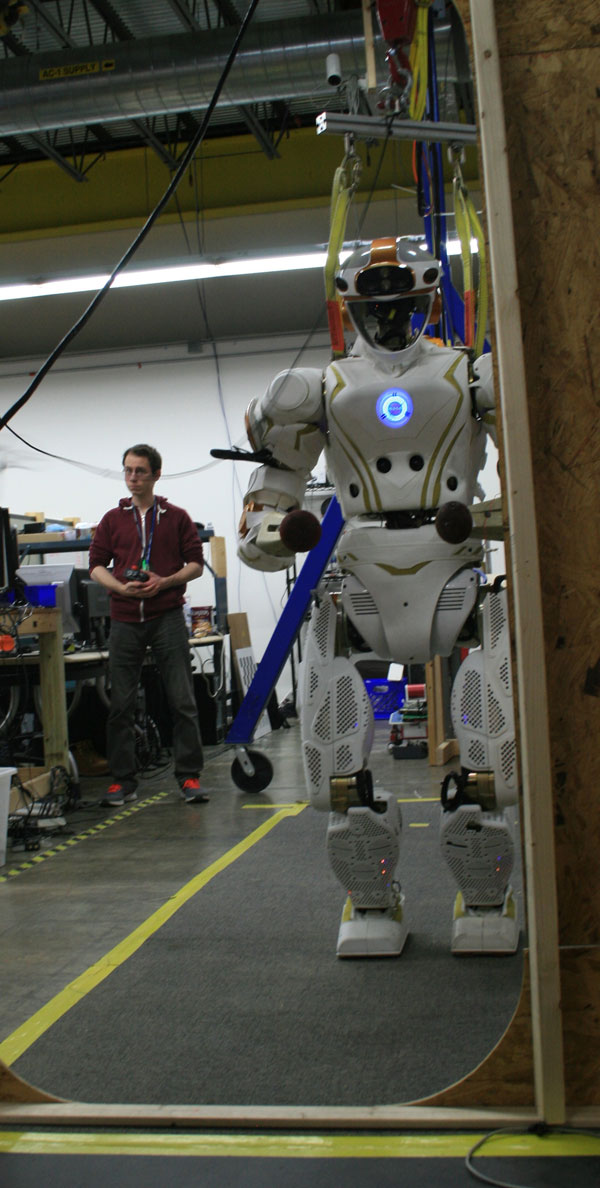In just a month, teams will guide this 300-pound, 6-foot-tall humanoid robot in a series of simulated trials as part of NASA’s Space Robotics Challenge.

S&T: Monica Young
Meet Valkyrie: She’s 6 feet and 2 inches tall, weighs about 300 pounds, and cost $2 million — and one day this humanoid space robot, or more likely her much more advanced descendant, might help humans colonize Mars.
Although that ultimate goal is still a long ways off, Valkyrie, a prototype developed by NASA's Johnson Space Center, will take her first Martian-specific test next month, as 20 teams guide a simulated version of the robot through a set of scenarios. Winners may take home a hefty prize: $1 million is on the table.
Valkyrie: A Tour
At first sight, Valkyrie looks not unlike Iron Man, the glowing circle on her chest marking her status (blue when motors are engaged, for example). But draw back the infrared-transparent faceplate and instead of Tony Stark, you’ll find a whirring LIDAR sensor that’s constantly scanning the surroundings for objects and obstacles.
Cameras and sensors abound on Valkyrie — in addition to a MultiSense SL camera on her head, which combines laser, 3D stereo, and video to get a sense of the environment around her, additional “hazard cameras” look ahead and behind from her torso. On each three-fingered hand, 38 sensors help maintain dexterity. Numerous small motors (actuators, in engineer-speak) control the robot’s 44 degrees of freedom, including seven-jointed arms.
The brains of the robot are two Intel Core i7 computers, which combine the sensors’ input and determine the best course of action. And, while testing is generally done with a power cord in place, Valkyrie also has a battery pack that’s good for about an hour.
All of that sensing, computing, and moving will be essential to Valkyrie’s future mission on Mars. While NASA initially developed Valkyrie (or, as she was initially called, R5), for disaster relief, in 2014 the agency changed course to reconfigure her for deep space. As one of a class of "caretaker" robots, Valkyrie might help set up living compounds on Mars, maintaining power and life support systems until the humans arrive.
Space Robotics Challenge
To that end, Valkyrie and the humans developing her are now facing space-based trials, such as the the Space Robotics Challenge that takes place in June. Here’s the setup:
In the not too distant future, R5 has arrived on Mars along with supplies ahead of a human mission. Overnight a dust storm damaged the habitat and solar array, and caused the primary communication antenna to become misaligned. R5 must now repair an air leak in the habitat, deploy a new solar panel, and align the communication antenna.
So basically, Valkyrie will replay the plot of The Martian, minus the part about growing potatoes.

S&T: Monica Young
Twenty teams will compete in the challenge, which is entirely simulated: teams will issue computer commands to a virtual Valkyrie, who will operate within a virtual Martian backdrop. But virtual doesn’t mean easy — teams will have to deal with strictly defined tasks, limited bandwidth, and a built-in latency designed to mimic the communications delay between Earth and Mars. You can follow the teams’ progress on Twitter.
But the Space Robotics Challenge is only one step of a marathon. NASA has also provided MIT and Northeastern University with Valkyrie prototypes for further development; Northeastern's Valkyrie is hosted at the NERVE (New England Robotics Validation and Experimentation) Center of University of Massachusetts, Lowell. A third group at the University of Edinburgh, Scotland, purchased a Valkyrie prototype from NASA.
These three teams are teaching Valkyrie complex subjects, such as how to walk across uneven surfaces and grasp different-shaped objects. They're also learning how robots and humans can best communicate with each other.
Why a Humanoid?
Whether you follow Valkyrie’s progress on Twitter or see a live demo of her abilities, as I did at the NERVE Center in April, one thing soon becomes clear: making a humanoid robot is hard. On the one hand, it’s pretty incredible to watch a person-shaped machine walk up and down a ramp or navigate a doorway. On the other hand, it’s also incredible how much work it has taken to get here.
“Valkyrie can currently walk over flat terrain by balancing her weight at all times,” says Taskin Padir (Northeastern University). “That’s why it looks slightly different than human walking.” The ability to walk on soft or uneven terrain, he adds, is the next goal.
Watch Valkyrie show off her balancing skills in this video:
Replicating humans’ ability to walk has long been a robotics goal, but it’s still not foolproof*, which is why space-based robots (such as Spirit, Opportunity, and Curiosity) have so far still relied on wheels to get around. But when it comes to, say, building human habitats on Mars, robots will have to be human-shaped — because ultimately, it will be humans, not robots, living and working on Mars.
* At least one other humanoid robot has made strides in walking ability, but Atlas, created by Boston Dynamics, is different from Valkyrie in some key ways. It can navigate freakily well across uneven terrain thanks in part to its hydraulic power, but fluid pressure (and possible accompanying leaks) is not particularly well-suited to space. So Valkyrie uses less powerful but more reliable electric actuators to keep her balance.
 8
8
Comments
Anthony Barreiro
May 17, 2017 at 9:33 pm
It is good PR to give the robot a feminine habitus and persona. But naming her Valkyrie takes away all the warm fuzzies. The Valkyries are virgin warriors who bring fallen heroes to Valhalla. I've read enough science fiction to know this is not going to end well.
You must be logged in to post a comment.
Monica YoungPost Author
May 18, 2017 at 9:49 am
Having read both science fiction and a tiny bit of Norse mythology...I have to admit the same thought occurred to me! Then again, she *is* going to Mars, named after a god of war. On the other side of things, two of the other famous humanoid robots are Atlas and Thor.
You must be logged in to post a comment.
Tom Hoffelder
May 18, 2017 at 6:52 am
Just send the robots. It would be a whole lot cheaper, and they could do it all. The high cost of human life support on Mars missions is going to delay them, if not keep them from ever happening at all.
You must be logged in to post a comment.
Anthony Barreiro
May 19, 2017 at 12:32 am
Plus, unlike humans, robots can be sterilized so they won't carry terrestrial microbes to Mars.
You must be logged in to post a comment.
Jim-Baughman
May 19, 2017 at 5:40 pm
But why make a “humanoid” robot? Ten times as much engineering (as well as expense) have gone into making this machine bi-pedal, and for what? What is to be gained by making a two-legged robot, with all its ultra-expensive balance system, instead of one whose balance can be achieved much more simply—say, a three-legged robot where stability is achieved by simple gravity?
And as to the “they will be cheaper in the long run” argument, one only has to remember the glowing forecasts of the “efficiencies” of the space shuttle, which ended up costing half a billion dollars each flight (not to mention the cost of the shuttles that were lost). Or remember even further back when scientists promised us nuclear-power energy that would be “too cheap to even meter”.
If NASA wants to develop robots like Curiosity, fine. But enough already of the expensive, virtually useless Star Wars props like Valkyrie.
You must be logged in to post a comment.
Aqua4U
June 8, 2017 at 3:00 pm
Key to making robots humanoid is so they can operate human tools presently in use or coming on line in the near future. These robots will build the infrastructure of lunar and martian colonies. Later.. humans arrive and can use the same tools.
You must be logged in to post a comment.
Andrew Hospador
May 19, 2017 at 9:58 pm
These humanoid robots can do virtually anything a human can do on an EVA at the space station. We met R5 and shook hands with her or one of her one of her brothers when visiting the Robonauts Team 118 robot shop on April 23, the day after the FIRST Robotics World Championships in Houston. Our FRC Robotics Team 5295 "Aldernating Current" from Shelton, WA concluded an amazingly successful competition season visiting the NASA Space Center.
You must be logged in to post a comment.
Rick
May 23, 2017 at 9:27 pm
Why not a four-legged robot.
• More stable.
• Could navigate uneven terrain (boulders, ditches, protrusions, etc.)
• Could also go vertical as needed (like great apes do).
• Additional "arms" from back (technically easy having already been done from the shoulders) could do a lot of work and carry stuff.
Bad Idea to give in to the bi-pedal attitude.
Rick Littleton
P.S. Monica Young is one of the best writers around.
You must be logged in to post a comment.
You must be logged in to post a comment.